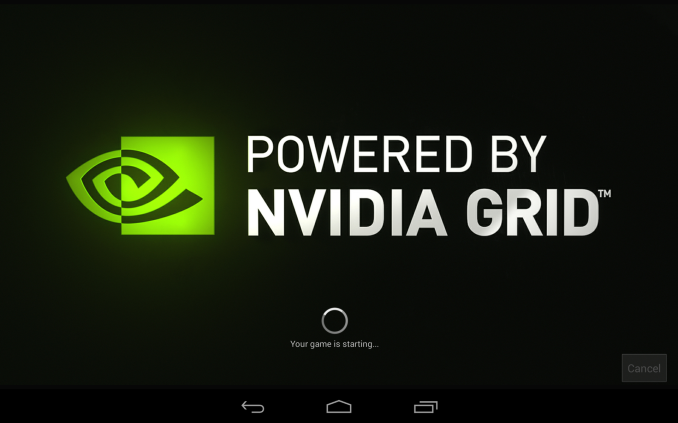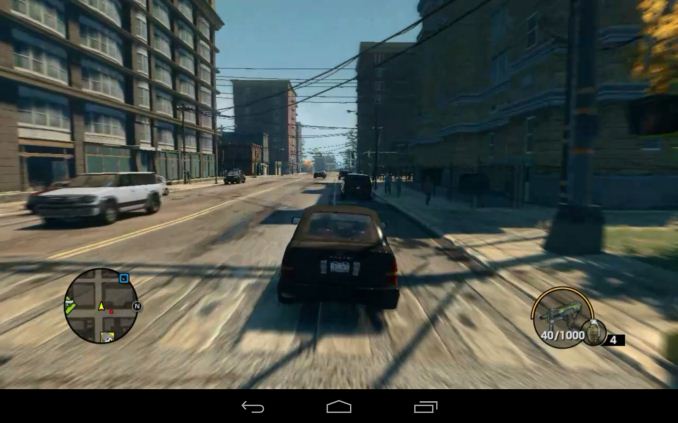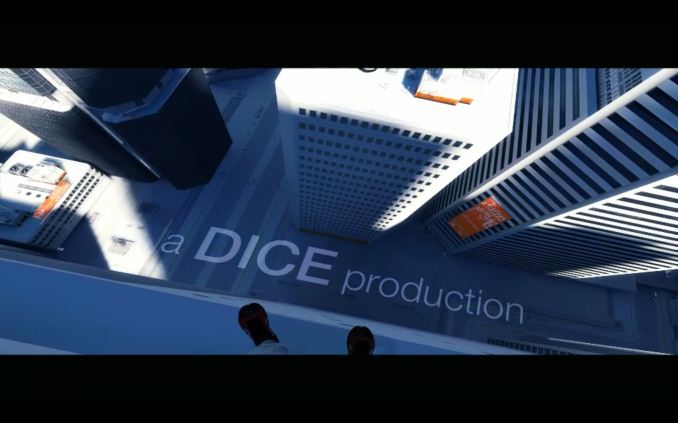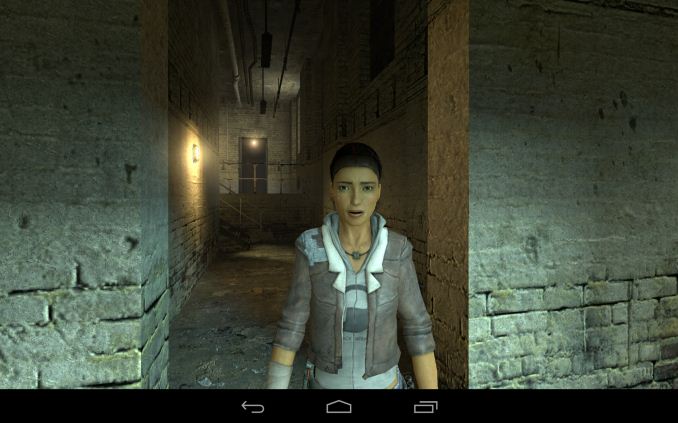The NVIDIA SHIELD Tablet Review
by Joshua Ho on July 29, 2014 9:00 AM ESTGameStream and GRID
The final software features that Shield Tablet brings to the table are GameStream and GRID. These are effectively methods of turning the tablet into a thin client, as all of the rendering/computation is done on a computer either in the LAN or on a server in San Jose. From a technical perspective, both work great as long as the connection has high bandwidth and low latency. For GRID, I managed to get a great user experience on a symmetrical 10 Mbps connection and around 10ms latency to the server. Games like Saints Row 3 played as if running on a console when the device is actually streaming from NVIDIA servers. From the user’s perspective, it’s a matter of going into the app drawer, opening GRID, and selecting a game. It’s simple and given sufficient server coverage I could easily see a Netflix-style usage model taking off quite successfully.
Although I didn’t spend as much time with GameStream, I didn’t detect any input lag and for the most part it’s just as simple. As long as a GameStream-enabled PC is on the same network, accessing GameStream compatible games is just a matter of going to the Shield Hub application, entering a four digit code on the PC to pair it with the tablet, and selecting a game. GameStream also works remotely, but the same caveats that come with GRID apply to GameStream on both the server and client end. Of course, the games that will run on GameStream have to be carefully selected. While it’s fully possible to play a twitch shooter like Call of Duty through GameStream, trying to use a controller in multiplayer is simply a massive disadvantage against people that are competent with a mouse and keyboard. I've included a screenshot of Mirror's Edge that I took while testing GameStream.
Gaming Ecosystem
Ultimately, I’m a bit conflicted on whether GameStream and GRID are really designed to stand on their own though. GameStream only works while you’re at home, and GRID is highly dependent upon low latency and also needs around 10 Mbps download and 5 Mbps upload for an ideal experience. Due to the latency requirement and the fact that the only GRID server bank is in San Jose, the very low latencies that GRID is best suited for are generally only achievable in California and parts of other nearby states. They’re definitely great in the situations that they work, but ultimately the native game library has to stand alone. To this end, the tablet is in a far better situation than the original Shield. The number of games that provide a quality gaming experience is now leaps and bounds better than what we saw with the launch of the Shield Portable. Trine 2 is included out of the box, and while I didn’t get a chance to try co-op mode it’s a compelling experience that once needed GameStream or GRID to be played on Shield. Along the same lines, the Grand Theft Auto series, Half Life 2, and Portal all play surprisingly well.
Fundamentally though, I don’t think single player games alone will sell Shield as a gaming platform. A single player game can only have a certain amount of replay value. Something like Half Life 2 might have 12 hours of gameplay at best. In comparison, multiplayer has massive amounts of replay value because even the same map can play out differently depending upon the people that play in the round. It’s that factor that makes it possible for people to spend 1200 hours playing a game like Battlefield 2. Unfortunately, for the most part the Shield tablet has a game library that seems to be skewed towards single player games. Fortunately, NVIDIA seems to understand this. While I haven’t been able to play War Thunder on Shield tablet, the promise of compelling multiplayer games on this device would be a strong enough reason to excuse potential shortcomings in other areas. Although it's good that an immersive multiplayer title is coming to Shield tablet, the key point of emphasis is that people playing a Shield device can play with those on console or PC as well. Until NVIDIA hits critical mass for Shield device adoption, multiplayer titles that only allow people on Shield to play with others on Shield will struggle because people won't play multiplayer unless there are other people to play with.















174 Comments
View All Comments
ams23 - Tuesday, July 29, 2014 - link
Oh and by the way, Shield tablet has a native resolution of 1920x1200. The 1080p offscreen tests in GFXBench are done at a resolution of 1920x1080. They are not the same thing! Shield tablet native resolution is higher than the 1080p offscreen resolution, and that is why fps is always a bit lower onscreen vs. offscreen.lucam - Wednesday, July 30, 2014 - link
I almost agree with you. Nevertheless it's worth saying this is the first Nvidia SOC with so fast GPU. Having this sort of performance might have a drastic trade off on power consumption. I think if the A8 will have similar performance of K1 and better energy saving then yes. I doubt, by the way, the A8 will have better performance. In this round Nvidia has made better GPU performance. Question would be...isn't enough to sell enough tablets?UpSpin - Friday, August 1, 2014 - link
Nice how you throw around you with meaningless numbers. Let's get your nonsense right:Performance:
I use this benchmark comparison as base:
http://gfxbench.com/compare.jsp?benchmark=gfx30&am...
The iPad Air has a 30WHr battery, got released on November 1, 2013 and costs $500.
The NVidia Shield tablet a 20WHr battery, got released now and costs $300.
The iPad Air has in the GFX battery rundown a power consumption of 5.4WHr.
The NVidia Shield tablet hasin the GFX battery rundown a power consumption of 9.38WHr.
The iPad Air vs. the NVidia Shiled tablet has an average frame rate of
Manhatten: 12.7 FPS vs 31 FPS -> 2.44x
T-Rex: 26.2 FPS vs 65 FPS -> 2.48x
Long Term: 21.3 FPS vs 56.3 FPS -> 2.65x
Now let's put all the things together, considering the higher performance of the Tegra K1, together with the higher power consumption but also higher battery capacity of the iPad Air and we get:
The Shield Tablet consumes 1.73 times the power of the iPad Air, but performs 2.65 times faster.
If Apple clocks the A7 higher, so it consumes the same power the Tegra K1 does, the Tegra would be 1.53 times faster. Now add the fact that the Tegra K1 supports Full Open GL 4.4 and one should see, the GPU of Tegra K1 is a monstrosity. Not so the outdated A15 CPU, but for this they will release the 64bit version soon, which will fix this limiting factor.
Efficiency:
Web browsing: 10hr vs. 10.8hr -> iPad: 3Whr vs. Nvidia: 1.85Whr
Conclusion:
The Tegra K1 is faster and more efficient.
Guspaz - Tuesday, July 29, 2014 - link
The GPU is definitely fast, but how power efficient is it? If they've made a GPU that produces 2x the performance at 3x the power draw, then that's not going to be terribly competitive.Are there any tests that could validate this? Something like a GPU benchmark performed at a fixed framerate with the screen off?
ams23 - Tuesday, July 29, 2014 - link
One would have to measure at the voltage rails (which is what NVIDIA did when comparing TK1 to S800 and A7).grahaman27 - Tuesday, July 29, 2014 - link
Its definitely more efficient. Nvidia claims its 1.4x as efficient.melgross - Tuesday, July 29, 2014 - link
Over the years, Nvidia has made a lot of claims that have turned out to not be true. I'd like to see the measurements.FriendlyUser - Tuesday, July 29, 2014 - link
The technology is cool and it really looks like a premium product, something relatively rare in the android space. However, I'm still looking for a use case. I mean, why would I stream from a PC instead of playing on the PC, if it is in the vicinity? And why would anyone pay serious money for gaming on the go instead of just using a smartphone for the few moments were mobile gaming might be interesting. And, if someone really needs to game on the go, 2.5h seems too few...Anyway, the technology is really nice and the execution is quite good. If I were in the market for a tablet I would think about it. Not tempted to upgrade, though.
SpartyOn - Tuesday, July 29, 2014 - link
I have a 1st gen Shield and it's for people like me: someone who sits at a desk all day and when he comes home doesn't want to sit at another desk or use a mouse anymore. I used to hook my mITX PC up to the HDTV and play with a controller, but then when I wanted to play an RTS or an MMO, I would move it back to my study. That's just cumbersome and requires a ton of wires in both locations.With the Shield, I can carry it around easily as a handheld and hook it up to my TV in Console Mode to get 1080p game streaming - all while now leaving my PC in the study for good. A couple other great use cases: playing PC games in bed while still being able to chill with my wife, outside enjoying fresh air, sitting on the toilet, and I've even sat on a lounger in the middle of my pool and streamed games.
If playing PC games in the middle of a pool surrounded by sunshine doesn't sound boss, then I don't know what is.
FriendlyUser - Tuesday, July 29, 2014 - link
Yeah, admittedly playing in a pool does sound cool. You do have a point there. My major obstacle would be paying for the pool, I guess...